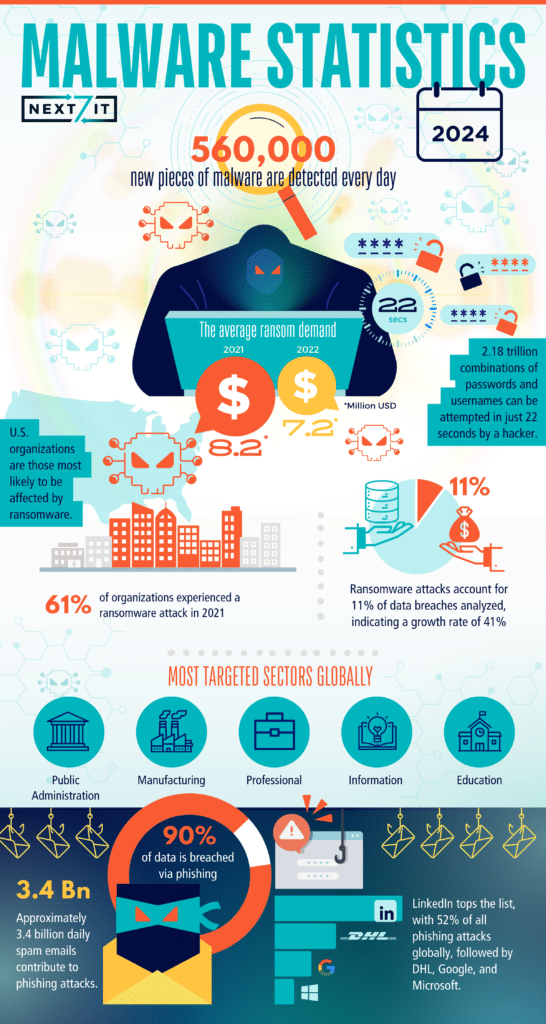As technology advances, so does the threat landscape, with malware evolving into a significant concern for organizations globally. With a staggering 560,000 new malware instances detected daily and over 1 billion already in circulation, the challenge to secure systems is more pressing than ever.
The malware statistics in 2024 are undeniably shocking. Whether you’re curious to see how malware has affected the world, or want to take action for your business, you should consider these malware statistics.

General Malware Statistics
- Phishing attacks are among the most popular attack methods (Source).
- As of 2022, Google issued over 3.849 million browser warnings to users who were trying to access a potentially harmful site (Source).
- Malware attacks dipped in 2020 for the first time since 2015, but are on the rise again (Source).
- In 2022, 60.1% of detected malware could be attributed to malware attacks over encrypted SSL/TLS traffic (Source).
- Professional services are among the most common targets for ransomware attacks (Source).
- 61% of organizations experienced a ransomware attack in 2021 (Source).
- Since January 2023, there have been 90,945 ransomware detections on endpoints (Source).
- The cost of cybercrime is predicted to reach $8 trillion by the end of 2023 (Source).
- There are over 1 billion malware programs that exist (Source).
- 560,000 new pieces of malware are detected every day (Source).
By Attack Type
Unfortunately, there is not just one type of cybersecurity attack, there are many. Each type of attack can threaten both individuals and businesses, so it’s essential to understand how these might affect you. Having a responsive and reliable help desk support team to hand is one of the best ways to quickly resolve any cybersecurity threats that you face.
Phishing Attacks
- Approximately 3.4 billion daily spam emails contribute to phishing attacks, responsible for 90% of data breaches (Source).
- Phishing attacks are responsible for 90% of data breaches (Source).
- LinkedIn tops the list, with 52% of all phishing attacks globally, followed by DHL, Google, and Microsoft (Source).
- Norton reports that about 88% of organizations face spear phishing attacks annually, showing a high frequency of targeting (Source).
Phishing attacks often use sophisticated tools and methods to coherse their potential victims into giving over sensitive data and steal from them. Thankfully there are plenty of ways to protect yourself against phishing attacks.
Ransomware Attacks
- In 2022, there were 493.33 million ransomware attacks, although there was a 21% decrease from the previous year (Source).
- Ransomware accounted for 12% of critical infrastructure breaches, significantly impacting various sectors (Source).
- The average ransom demand in 2022 was $7.2 million, down from $8.2 million in the previous year (Source).
- In 2022, the IC3 received 2,385 ransomware complaints, exceeding $34.3 million in losses (Source).
- The average downtime a company experiences following a ransomware attack is 22 days (Source).
- U.S. organizations are those most likely to be affected by ransomware (Source).
- In February 2023, the City of Oakland in California declared a local state of emergency following a ransomware attack (Source).
Distributed Denial of Service (DDoS) Attacks
- Microsoft handled an average of 1,435 DDoS attacks daily, with a maximum of 2,215 attacks in a single day in 2022 (Source).
- Online industries saw a surge in application-layer DDoS attacks, growing by 131% quarter-on-quarter (Source).
- Google services experienced a record-breaking DDoS attack in 2017 which reached a huge 2.54Tbps in size (Source).
- In March 2023, the French National Assembly experienced a temporary outage due to a DDoS attack by Russian hackers (Source).
Password Cracking Attacks
- 80% of all data breaches could be attributed to compromised passwords in 2019, with 49% of users only changing one letter or digit in their password (Source).
- 2.18 trillion combinations of passwords and usernames can be attempted in just 22 seconds by a hacker (Source).
- An eight-character password could be cracked in just one second, but this increases to 22 minutes by adding one upper case letter (Source).
- A Google survey in 2019 revealed it’s common for people to reuse passwords across multiple accounts (Source).
- 8% of surveyed participants said they believed they had a strong password (Source).
Cybersecurity Statistics
- The leading causes of ransomware incidents were phishing, software vulnerabilities, and the exploitation of Remote Desktop Protocol (RDP), according to an IC3 report in 2022 (Source).
- LockBit, ALPHV/Blackcoats, and Hive were the main ransomware variants that were reported to IC3 (Source).
- Business email compromise, legacy protocols, and password reuse are said to be the most common vulnerabilities (Source).
- IoT malware has increased by 87% in 2022 compared to 2021, resulting in 112.3 million cases (Source).
- Cybersecurity technology and service providers are said to be worth $2 trillion as a response to protecting against cyber threats (Source).
- The average cost of a data breach has increased from $4.24 million in 2021 to $4.35 million in 2022 (Source).
- Ransomware attacks account for 11% of data breaches analyzed, indicating a growth rate of 41% (Source).
- The FBI IC3 receives an average of 652,000 complaints annually (Source).
- Organizations spend around 109% of their IT budget on cybersecurity (Source).
Most Targeted Sectors Globally
Some industries are targeted more than others, here are the top 10 sectors that statistically are more likely to be targeted by Malware attacks.
- Public Administration
- Manufacturing
- Professional
- Information
- Education
- Transportation
- Retail
- Healthcare
- Finance
- Utilities
Of course, even if your business doesn’t fall into one of these sectors, it doesn’t mean you are safe from Malware, these are just the businesses that have statistically be more commonly targeted over the years.
How to Prevent Falling Victim to Malware
These Malware statistics are shocking to read, and show how easy it can be to fall victim to malware attacks, but thankfully there are some steps you can take to prevent yourself from becoming another Malware statistic yourself.
If you’ve fallen victim to Malware, or simply want to protect yourself and your company from malicious attacks, contact us today to see how we can keep your IT systems safe.
Oops! We could not locate your form.

